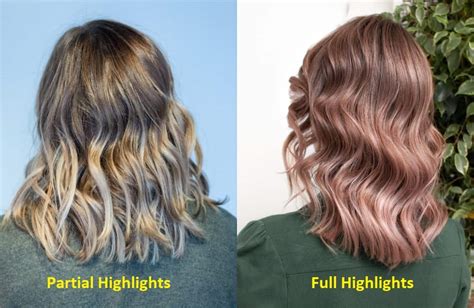When it comes to hair highlighting, the choice between partial and full highlights can seem daunting. Both techniques offer distinct advantages, suiting different styles and preferences. This comprehensive guide will delve into the intricacies of partial vs full highlights, empowering you to make an informed decision.

Partial Highlights: A Touch of Illumination
Partial highlights, also known as half highlights, subtly illuminate select sections of your hair, creating a natural-looking glow. This technique focuses on adding dimension and enhancing texture, without drastically altering your overall color.
Key Benefits:
- Maintains a natural base color
- Adds depth and movement
- Ideal for low-maintenance upkeep
- Suitable for all hair types and textures
Full Highlights: Radiance from Root to Tip
Full highlights saturate your entire head of hair with color, transforming its appearance. This technique achieves a bold, vibrant look that draws attention to your hair. It’s perfect for creating a dramatic statement or covering gray hairs.
Key Benefits:
- Maximum brightness and impact
- All-over color transformation
- Can be customized to create various effects
- Ideal for medium to long hair lengths
Partial Highlights vs Full Highlights: A Comparative Analysis
To further clarify the differences between partial and full highlights, here’s a simplified comparison:
| Feature | Partial Highlights | Full Highlights |
|---|---|---|
| Saturation | Subtly illuminates selected sections | Saturates entire head of hair |
| Maintenance | Low-maintenance touch-ups | Requires more frequent touch-ups |
| Cost | Typically less expensive | Typically more expensive |
| Suitability | All hair types and textures | Medium to long hair lengths |
Common Mistakes to Avoid
- Over-highlighting: Excessive highlighting can damage hair and create an unnatural appearance.
- Unrealistic expectations: Partial highlights won’t drastically alter your base color.
- Improper technique: Inexperienced stylists may apply highlights unevenly or incorrectly.
- Neglecting aftercare: Highlighting requires special care to maintain hair health.
Pros and Cons: A Breakdown
To aid your decision-making, here’s a breakdown of the pros and cons of each technique:
Partial Highlights
Pros:
- Natural-looking results
- Low-maintenance upkeep
- Less damage to hair
Cons:
- Subtle transformation
- May not fully cover gray hairs
Full Highlights
Pros:
- Dramatic color transformation
- Can be customized for various effects
- Covers gray hairs effectively
Cons:
- Higher maintenance requirements
- More expensive
- Potential for hair damage
FAQs: Clearing Up Your Doubts
1. Which technique is better for short hair?
Partial highlights are ideal for short hair, adding subtle dimension and avoiding an overly highlighted look.
2. Can I highlight my hair myself?
Attempting highlights at home is not recommended. Professional stylists are equipped with the skills and experience to ensure even, damage-free results.
3. How often should I get touch-ups?
Partial highlights require less frequent touch-ups (every 8-12 weeks), while full highlights may need touch-ups every 4-6 weeks.
4. How long does the highlighting process take?
The time it takes varies depending on the technique used and the length and thickness of your hair. Partial highlights usually take 2-3 hours, while full highlights can take 4-6 hours or more.
5. Is highlighting damaging to hair?
Highlighting, if done correctly, can be minimally damaging. Using quality products and following proper aftercare techniques can help protect hair health.
6. How can I maintain my highlights?
Regular deep conditioning, using sulfate-free shampoos, and minimizing heat styling can help prolong the vibrancy and longevity of your highlights.
Innovative Applications of Highlights: A Creative Canvas
Beyond traditional highlighting, there’s a world of innovative applications to explore:
- Contouring Highlights: Strategically placed highlights can create the illusion of depth and shape on the face.
- Balayage Highlights: A freehand painting technique that creates seamless, natural-looking transitions.
- Ombré Highlights: A gradual blend of two or more shades, creating a soft, sophisticated effect.
- Reverse Highlights: A process that lightens only the darker sections of hair, creating a unique dimensional look.
Conclusion
Whether you prefer the subtle glow of partial highlights or the bold impact of full highlights, there’s a technique that can transform your hair. By carefully considering your goals, hair type, and lifestyle, you can confidently choose the perfect highlight option to enhance your natural beauty and create a look that truly reflects your style.
